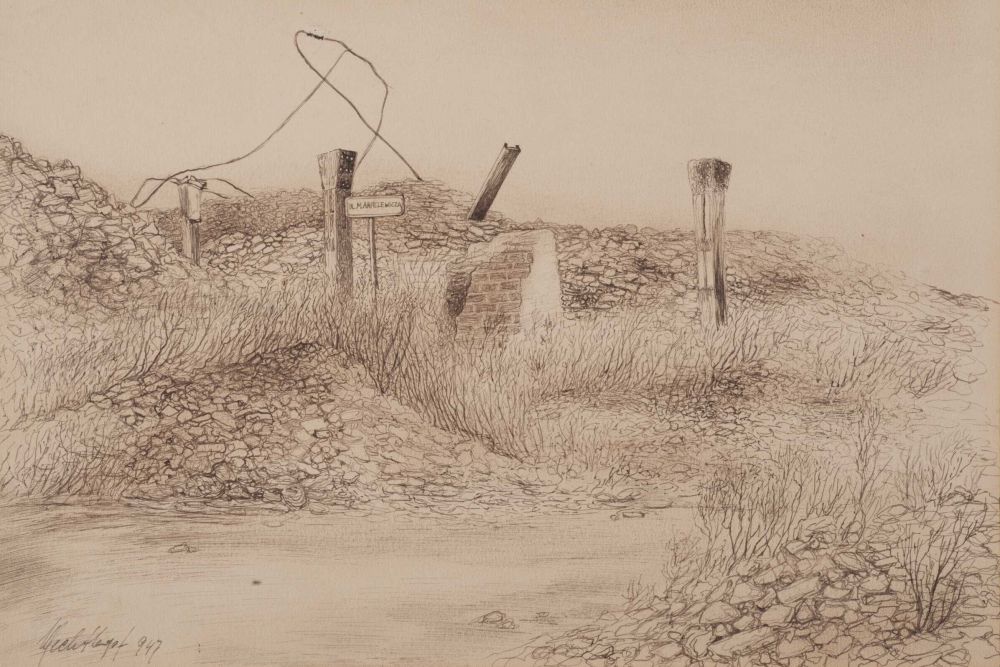- News
- Events
- Oneg Shabbat
- Collections
- Research
- Exhibitions
- Education
- Publishing Department
- Genealogy
- About the Institute
- Bookstore


Henryk Hechtkopf, "The Warsaw Ghetto – Anielewicza Street", the collection of the JHI
This year's March of Remembrance on July 22, 1942, will be accompanied by the “Roots of the Uprising. Resistance in the Warsaw Ghetto” exhibition. One of its elements will be a flower meadow of memory, composed of species typical of the former Muranów district. Even before their appearance, some of them were cultivated in gardens and pots, while others grew there spontaneously as weeds. Many are common in Warsaw and its vicinity, despite the efforts to exterminate them from lawns, flower beds, or flower meadows. Several species, common in the ruins of the Jewish quarter in 1945-49, are rather rare today. It concerns the ruderal, but very thermophilic, quinoa, annual mugwort, and Virginian pepper, as well as the silene flos-cuculi often found on utility meadows, and finally, the gypsophila paniculata, which is partially protected today.
The flower meadow of memory will be created in the form of a sod system, typical of extensively used green roofs. This system will consist of elements of pots, vegetation and protective mats, substrate, filtration fabrics, internal insulation, and finally drainage, with a height of 0.1 m and a weight of approximately 110 kg/m2. The entire exhibition will take 31 m2, and the meadow itself 17 m2. Specimens collected by the creator of the meadow, Natalia Budnik, a landscape architect, were planted in pots, while native and ruderal seed plants were sown on mats, whether collected by hand or obtained from community seed banks. Reseeding seeds in successive batches, at intervals, allow them to stretch their growth for a few weeks. The flower meadow of memory will be supplied with rainwater, retained in buckets of the pot system, and then diffused through mats to the roots. Shown exhibitions are two-year-old forms and permanent (perennials) installations transplanted into additional pots. Seeds of annual flowers and grasses and the entire swath with seeds will go to allotment gardeners.
The list of species typical for the ruins of the ghetto was prepared by Prof. Roman Kobendza (February 15, 1866–November 24, 1955), botanist and social worker associated with the Free Polish University and the Botanical Garden of the University of Warsaw, then with the Warsaw University of Life Sciences, meritorious for establishing national parks in the Kampinos Forest and the Świętokrzyskie Mountains, as well as the Botanical Garden of the Polish Academy of Sciences in Powsin. Kobendza was a person especially predestined to develop such lists. Coming from a poor, rural family, from childhood he was in contact with cultivated species and their undesirable companions. As a Mazovian regionalist, the author of numerous works on the vegetation of the capital and its vicinity, especially city parks, he was well acquainted with the species introduced here by people or inadvertently. Working according to the criterion of the inspector of the Botanical Garden of the University of Warsaw, he combined scientific observations with "hunting" for interesting specimens for the Garden in various regions of Mazovia, Kielce, and Volhynia, he was supposed to masterly find interesting ones and then transplant them to the target division. Kobendza, as an anatomist of plants, has devoted a lot of attention to the root systems of plants, including the unusual modifications of roots in the rubble of Warsaw, including the ruins of the Ghetto. As an ecologist of plants, he was fascinated by their struggle with the moving ground with sand, such as in the dunes of Kampinos or the stone runs in Świętokrzyskie Mountains. This is the reason for his interest in rubble as a kind of previously unknown to him moving base.